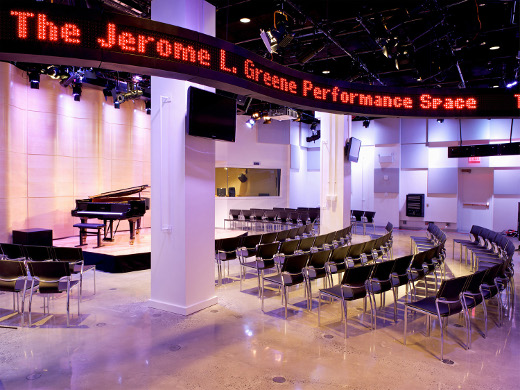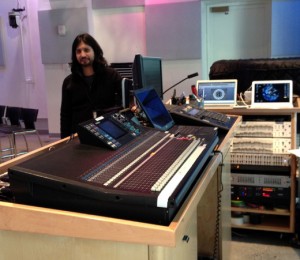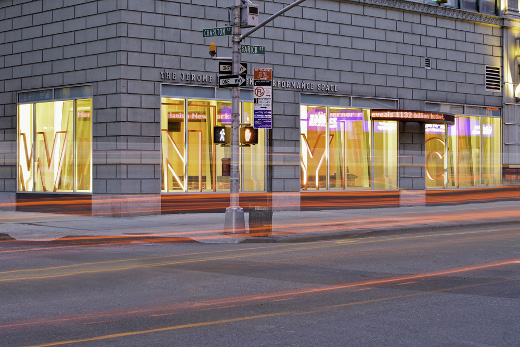Inside WNYC & WQXR’s Jerome L. Greene Performance Space
TRIBECA, MANHATTAN: The Jerome L. Greene Performance Space, with its huge street-level windows, is fittingly public for a venue that’s run by New York Public Radio. Looking at the Greene Space from the street, you’re treated to a view straight into the heart of this 1,800-square-foot theater, making each show something of an open exhibition.
The venue, which first opened in April 2009, is now slated to enter its 5th year of operation, busier than ever. There are already well over 100 in-house events planned for 2014, from news and cooking shows to book readings and live concerts.
These in-house programs are usually produced in conjunction with NYPR’s flagship stations, the talk-focused WNYC, and the all-classical station, WQXR. But that’s not all that goes on at The Greene Space.
On the remaining calendar days, the venue is often rented by outside production companies that come for the room’s full-service multimedia amenities, and its crack A/V crew led by production manager Ricardo Fernandez – an audio engineer who began his career as an assistant at Avatar Studios years ago.
On the audio side, the facilities boast a customized API Vision console in the control room, a Yamaha digital board for the front of house position, a cache of Neumann KMS 105s and Shure Beta 58s, and access to the entire station’s extensive collection of mics to use on instruments, including the room’s own Fazioli grand piano.
As for video, the performance space comes equipped with a 110” projection screen, 5 large LCD monitors throughout the theater, and a separate video production room that offers remote control over the 5 HD cameras installed throughout the space.
Full-fledged events at this Gold LEED-certified space tend to be staffed by at least 4 A/V crew members. Studio audiences are often in the range of 110-125 (occasionally topping out at 300 or more) and performances are frequently broadcast live on the radio, then made available in audio or video archive.
In-house music programming has been a feature at The Greene Space since its opening days, when the late Lou Reed gave the room’s inaugural performance for a live broadcast of John Schaefer’s Soundcheck. Concerts have continued ever since, and the space has hosted artists from Elvis Costello to Sharon Jones, Wynton Marsalis to Philip Glass.
Upcoming music events include an intimate performance by renowned concert violinist Joshua Bell, and the 5th Annual Battle of the Boroughs – a city-wide talent search that draws on hundreds of bands in order to select a group of semi-finalists from each borough. The winning bands will then compete head-to-head in a series of 5 concerts, before squaring off in a final round this summer. (Musicians can apply to enter for the upcoming season until December 31st, 2013.)
A Non-Profit Success Story
The Greene Space is now a flourishing non-profit venue that stands glistening on the corner of Varick and Charlton like a finely cut jewel. But it’s also a space that would have been difficult to foresee WYNC building back in 1994 – the year Rudy Giuliani decided that the city ought to sell off the then municipally-owned radio station, in order to help the city balance its long-overdrawn budget.
After the city sold its radio properties to the WNYC Foundation for a price of $20 million to be paid over six years (far less than what they would have commanded on the open market), the station began to grow its programming and its budget, making it a point to progressively increase professionalism, listenership and quality of programming, year by year.
Since then, the organization has become something of a fundraising success story, consistently motivating listeners to give, and even folding in corporate underwriters while largely managing to keep its non-profit credibility intact. Today, WNYC has gone from a struggling governmental budget liability to a public radio mini-empire that takes in over $63 million dollars in revenue, and leaves enough left at the bottom of their balance sheet in order to keep a growing reserve of almost $88 million in assets.
In the process, this public radio group has managed to free itself from the political pressures and inherent limitations of remaining another line item on a swollen city budget. And it’s this kind of independence that has allowed NYPR to take on ambitious projects like building and running the Jerome L. Greene space. Its success here is also a gain for other non-profits, which can book this over-designed and multifaceted venue at a significantly discounted rate.
I first encountered the Greene Space when I was lucky enough to catch the first-ever live episode of WNYC’s On The Media, and an experimental pilot run of Radiolab‘s popular touring show “In The Dark.” With their seamless integration of technology, talk, and good music, the best shows at The Greene Space suggest new heights that great live performances of the 21st century can aspire to reach.
Justin Colletti is an audio engineer, educator and journalist.
Please note: When you buy products through links on this page, we may earn an affiliate commission.









